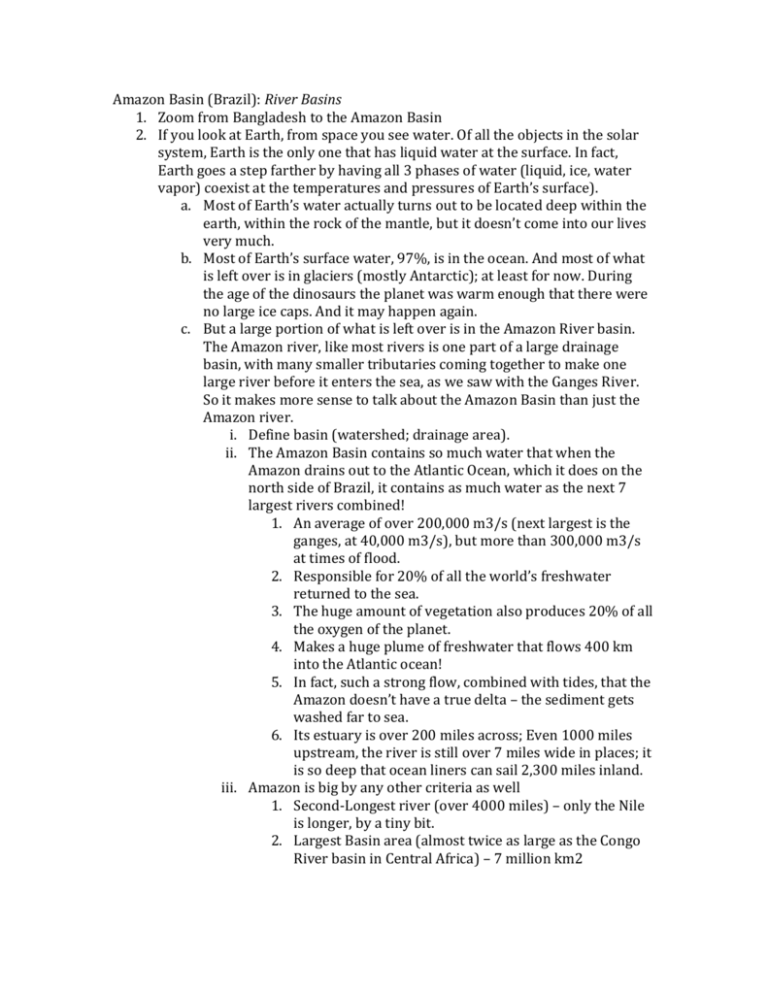Amazon_Out
advertisement

Amazon Basin (Brazil): River Basins 1. Zoom from Bangladesh to the Amazon Basin 2. If you look at Earth, from space you see water. Of all the objects in the solar system, Earth is the only one that has liquid water at the surface. In fact, Earth goes a step farther by having all 3 phases of water (liquid, ice, water vapor) coexist at the temperatures and pressures of Earth’s surface). a. Most of Earth’s water actually turns out to be located deep within the earth, within the rock of the mantle, but it doesn’t come into our lives very much. b. Most of Earth’s surface water, 97%, is in the ocean. And most of what is left over is in glaciers (mostly Antarctic); at least for now. During the age of the dinosaurs the planet was warm enough that there were no large ice caps. And it may happen again. c. But a large portion of what is left over is in the Amazon River basin. The Amazon river, like most rivers is one part of a large drainage basin, with many smaller tributaries coming together to make one large river before it enters the sea, as we saw with the Ganges River. So it makes more sense to talk about the Amazon Basin than just the Amazon river. i. Define basin (watershed; drainage area). ii. The Amazon Basin contains so much water that when the Amazon drains out to the Atlantic Ocean, which it does on the north side of Brazil, it contains as much water as the next 7 largest rivers combined! 1. An average of over 200,000 m3/s (next largest is the ganges, at 40,000 m3/s), but more than 300,000 m3/s at times of flood. 2. Responsible for 20% of all the world’s freshwater returned to the sea. 3. The huge amount of vegetation also produces 20% of all the oxygen of the planet. 4. Makes a huge plume of freshwater that flows 400 km into the Atlantic ocean! 5. In fact, such a strong flow, combined with tides, that the Amazon doesn’t have a true delta – the sediment gets washed far to sea. 6. Its estuary is over 200 miles across; Even 1000 miles upstream, the river is still over 7 miles wide in places; it is so deep that ocean liners can sail 2,300 miles inland. iii. Amazon is big by any other criteria as well 1. Second-Longest river (over 4000 miles) – only the Nile is longer, by a tiny bit. 2. Largest Basin area (almost twice as large as the Congo River basin in Central Africa) – 7 million km2 3. Over 1100 different tributaries feed the Amazon; 17 of these are more than 1000 miles long themselves (a large portion of the world’s longest rivers are here!) 4. They carry varying amounts of sediment depending upon where they flow through; an unusual occurrence is where the Rio Negro (black river) meets the sandy Rio Solimoes. The water is black because of large amounts of humic acid from vegetation – like strong tea. 5. Adjacent to the Orinoco River basin; there is actually a natural canal between them. 3. Why, of all the places in the world, is there so much water here? a. First of all, to get so much water flowing out the Amazon, we need to have a lot of rain. And the Amazon Basin receives an enormous amount of rain. i. Now, there are some places in the world that average more rain per area over the course of a year (more than 10 meters per year!) 1. Mt. Wai’ale’ale, Kauai, Hawaii 2. Mt. Tutendo and Lloro, Colombia 3. Mawsynram and Cherrapunji, Meghalaya, India ii. But Nothing compares to the total rainfall received over the whole Amazon region. b. To understand that, we have to look at why it rains in the first place. i. Explain Atmospheric Circulation 1. Sunlight at equator 2. Evaporation at the sea surface 3. Thermal convection 4. Condensation/precipitation at colder T (higher) 5. Coriolis effect 6. Westward air currents at equator 7. Andes Mts, blocking and lifting air 8. So, moist warm air comes off the Atlantic, cools as it travels up across central South America, and rains out. c. The Andes is the longest mountain range in the world, and the tallest outside of Asia, so it not only provides an efficient block to the moisture, but provides a vast amount of sediment, which provides for fertile soils all across the Amazon basin. 4. The Amazon has a wet season and a dry season. Varies by region, but generally Jan-June is wet and July-Dec is dry. Water levels throughout the Amazon can then rise and fall a lot. a. Very strange feature – flooding forests. Many forests are totally flooded for part of the year. b. Giant otters and manatees and 15-ft long arapaima fish and electric eels and schools of piranhas (some of which, the red-bellied piranhas, really will attack and kill humans and other large mammals) and all c. d. e. f. sorts of other animals will swim around the flooded forests, only to have these habitats then disappear for part of the year. There are relatively few people who live in the amazon basin because of how wet it is. Some villages are built on stilts, and get around by boat for part of the year. There are even some villages, like in Iquitos, Peru, that float. All the houses are built on rafts that float about. One fascination region: Anavilhanas Archipelago – the world’s largest freshwater archipelago, with over 400 river islands. Another remarkable region is the Pantanal, which is the world’s largest single wetlands region – about 75,000 sq miles (on Brazil, Paraguay, and Bolivia). About 80% of it is totally flooded during the rainy season. It is home to a remarkable diversity of species of plants, animals, and all other life forms. Rainforests around the world occupy about 2% of Earth’s surface, but contain about 50% of its species. Ironically, this remarkable biodiversity exists because rainforests have some of the worst geologic conditions for life, so there is an intense competition for resources, which leads to extreme diversity (explain). i. The vast amount of rain has rendered the soils there worthless. All nutrients of any value have long since washed down into the ground – soils can be many hundreds of feet thick. (explain) ii. Life has evolved to keep what nutrients are available above ground. (canopies of plants above ground; leaves that fall; in some places little rain actually reaches the ground) iii. Incredibly fortunate for us. 1. 80% of the world’s diet originated in rainforests – fruits like avocados, coconuts, figs, oranges, lemons, grapefruit, bananas, guavas, pineapples, mangos and tomatoes; vegetables including corn, potatoes, rice, winter squash and yams; spices like black pepper, cayenne, chocolate, cinnamon, cloves, ginger, sugar cane, turmeric, coffee and vanilla and nuts including Brazil nuts and cashews. 2. Over 3000 different fruits grown in rainforests. Natives eat about 2000. Only about 300 have made it yet to the Western World 3. Amazon rainforest is also a great place to find medicines – it would be impossible to start from scratch and come up with drugs to resist all bacteria and fungi; why bother? Plants and animals have done through evolution, developing all kinds of immunities and resistances. 4. About 25% of western drugs are made from rainforest products, even though far less than 1% of rainforest trees and plants have yet been tested. 5. The U.S. National Cancer Institute has identified 3000 plants that are active against cancer cells – 70% of these plants are found in rainforests. 6. Some of the biggest advocates for preserving rainforests are the pharmaceutical companies – this is where our future medicines will come from. 5. Top 5: a. Congo River (Democratic Republic of the Congo, Central African Republic, Angola, Republic of the Congo, Tanzania, Cameroon, Zambia, Burundi, Rwanda) – second largest in basin size and water outflow, only to the Amazon. b. Nile (Ethiopia, Eritrea, Sudan, Uganda, Tanzania, Kenya, Rwanda, Burundi, Egypt, Democratic Republic of the Congo, South Sudan); all of Egypt was green 5000-7000 years ago; the Nile is the only water from Sudan to the Mediterranean c. Mississippi (changed mouth many times since last ice age) – show map of Mississippi changes; Army Corps Engineers project to keep Mississippi in its current channel may be biggest engineering project in history d. Yenisey (largest river system that drains to the Arctic; its headwaters include Lake Baikal, which is the world’s deepest (over a mile – the bottom is almost 4000 feet below sea level), oldest (30 million years), and largest freshwater lake (20% of the world’s surface freshwater). Questions: 1. What would the Amazon basin be like if there were no Andes Mountains? 2. The island of Barbados, in the Caribbean, is at a subduction zone but is not a volcano, like most other islands there. It is made of sediments. Find it on a map; why do you think it is there?








